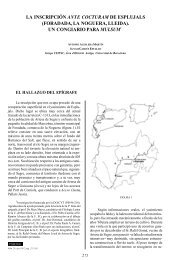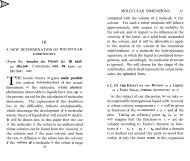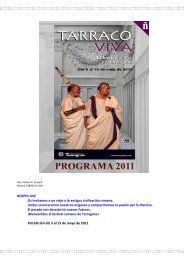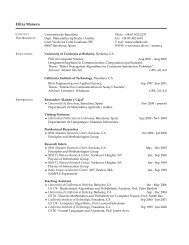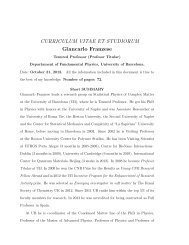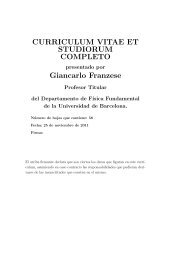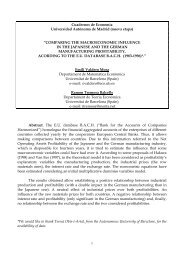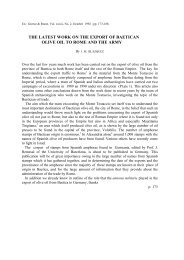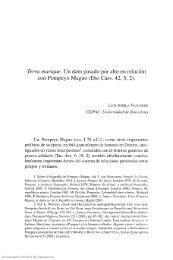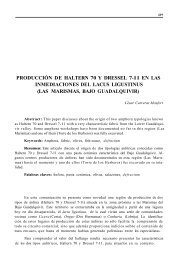3 On a Heuristic Point of View about the Creatidn and Conversion of ...
3 On a Heuristic Point of View about the Creatidn and Conversion of ...
3 On a Heuristic Point of View about the Creatidn and Conversion of ...
You also want an ePaper? Increase the reach of your titles
YUMPU automatically turns print PDFs into web optimized ePapers that Google loves.
3 <strong>On</strong> a <strong>Heuristic</strong> <strong>Point</strong> <strong>of</strong> <strong>View</strong> <strong>about</strong><br />
<strong>the</strong> <strong>Creatidn</strong> <strong>and</strong> <strong>Conversion</strong> <strong>of</strong> Light?<br />
A. EINSTEIN<br />
THERE exists an essential formal difference between <strong>the</strong> <strong>the</strong>oretical<br />
pictures physicists have drawn <strong>of</strong> gases <strong>and</strong> o<strong>the</strong>r ponderable<br />
bodies <strong>and</strong> Maxwell’s <strong>the</strong>ory <strong>of</strong> electromagnetic processes in<br />
so-called empty space. Whereas we assume <strong>the</strong> state <strong>of</strong> a body to<br />
be completely determined by <strong>the</strong> positions <strong>and</strong> velocities <strong>of</strong> an,’<br />
albeit very large, still finite number <strong>of</strong> atoms <strong>and</strong> electrons, we use<br />
for <strong>the</strong> determination <strong>of</strong> <strong>the</strong> electromagnetic state in space continuous<br />
spatial functions, so that a finite number <strong>of</strong> variables<br />
cannot be considered to be sufficient to fix completely <strong>the</strong> electromagnetic<br />
state in space. According to Maxwell’s <strong>the</strong>ory, <strong>the</strong><br />
energy must be considered to be a continuous function in space<br />
for all purely electromagnetic phenomena, thus also for light,<br />
while according to <strong>the</strong> present-day ideas <strong>of</strong> physicists <strong>the</strong> energy<br />
<strong>of</strong> a ponderable body can be written as a sum over <strong>the</strong> atoms <strong>and</strong><br />
electrons. The energy <strong>of</strong> a ponderable body cannot be split into<br />
arbitrarily many, arbitrarily small parts, while <strong>the</strong> energy <strong>of</strong> a<br />
light ray, emitted by a point source <strong>of</strong> light is according to<br />
Maxwell’s <strong>the</strong>ory (or in general according to any wave <strong>the</strong>ory) <strong>of</strong><br />
light distributed continuously over an ever increasing volume.<br />
The wave <strong>the</strong>ory <strong>of</strong> light which operates with continuous 6<br />
functions in space has been excellently justified for <strong>the</strong> representation<br />
<strong>of</strong> purely optical phenomena <strong>and</strong> it is unlikely ever to be<br />
replaced by ano<strong>the</strong>r <strong>the</strong>ory. <strong>On</strong>e should, however, bear in mind<br />
that optical observations refer to time averages <strong>and</strong> not to<br />
?Ann. Physik 17, 132 (1905).<br />
91
instantaneous values <strong>and</strong> notwithst<strong>and</strong>ing <strong>the</strong> complete experimental<br />
verification <strong>of</strong> <strong>the</strong> <strong>the</strong>ory <strong>of</strong> diffraction, reflexion, refraction,<br />
dispersion, <strong>and</strong> so on, it is quite conceivable that a <strong>the</strong>ory ai‘<br />
light involving <strong>the</strong> use <strong>of</strong> continuous functions in space will lead<br />
to contradictions with experience, if it is applied to <strong>the</strong> phenomena<br />
<strong>of</strong> <strong>the</strong> creation <strong>and</strong> conversion <strong>of</strong> light.<br />
In fact, it seems to me that <strong>the</strong> observations on “black-body<br />
radiation”, photoluminescence, <strong>the</strong> production <strong>of</strong> cathode rays by<br />
ultraviolet light <strong>and</strong> o<strong>the</strong>r phenomena involving <strong>the</strong> emission or<br />
conversion <strong>of</strong> light can be better understood on <strong>the</strong> assumption<br />
that <strong>the</strong> energy <strong>of</strong> light is distributed discontinuously in space.<br />
According to <strong>the</strong> assumption considered here, when a light ray<br />
starting from a point is propagated, <strong>the</strong> energy is not continuously<br />
distributed over an ever increasing volume, but it<br />
consists <strong>of</strong> a finite number <strong>of</strong> energy quanta, localised in space,<br />
which move without being divided <strong>and</strong> which can be absorbed or<br />
emitted only as a whole.<br />
In <strong>the</strong> following, I shall communicate <strong>the</strong> train <strong>of</strong> thought <strong>and</strong><br />
<strong>the</strong> facts which led me to this conclusion, in <strong>the</strong> hope that <strong>the</strong><br />
point <strong>of</strong> view to be given may turn‘ out to be useful for some<br />
research workers in <strong>the</strong>ir investigations.<br />
l. <strong>On</strong> a Difficulty in <strong>the</strong> Theory <strong>of</strong> “Black-body Radiatiora’’<br />
To begin with, we take <strong>the</strong> point <strong>of</strong> view <strong>of</strong> Maxwell’s <strong>the</strong>ory <strong>and</strong><br />
electron <strong>the</strong>ory <strong>and</strong> consider <strong>the</strong> following case. Let <strong>the</strong>re be in a<br />
volume completely surrounded by reflecting walls, a number <strong>of</strong><br />
gas molecules <strong>and</strong> electrons moving freely <strong>and</strong> exerting upon one<br />
ano<strong>the</strong>r conservative forces when <strong>the</strong>y approach each o<strong>the</strong>r, that<br />
is, colliding with one ano<strong>the</strong>r as gas molecules according to <strong>the</strong><br />
kinetic <strong>the</strong>ory <strong>of</strong> gases.? Let <strong>the</strong>re fur<strong>the</strong>r be a number <strong>of</strong> electrons<br />
which are bound to points in space, which are far from one<br />
This assumption is equivalent to <strong>the</strong> preposition that <strong>the</strong> average kinetic<br />
energies <strong>of</strong> gas molecules <strong>and</strong> electrons are equal to one ano<strong>the</strong>r in temperature<br />
equilibrium. It is well known that Mr. Drude has <strong>the</strong>oretically derived in<br />
this way <strong>the</strong> relation between <strong>the</strong> <strong>the</strong>rmal <strong>and</strong> electrical conductivities <strong>of</strong><br />
metals.<br />
EINSTEIN: CREATION AND CONVERSION OF LIGHT 93<br />
ano<strong>the</strong>r, by forces proportional to <strong>the</strong> distance from those points<br />
<strong>and</strong> in <strong>the</strong> direction towards those points. These electrons are also<br />
assumed to be interacting conservatively with <strong>the</strong> free molecules<br />
<strong>and</strong> electrons as soon as <strong>the</strong> latter come close to <strong>the</strong>m. We call<br />
<strong>the</strong> electrons bound to points in space “resonators”; <strong>the</strong>y emit <strong>and</strong><br />
absorb electromagnetic waves with definite periods.<br />
According to present-day ideas on <strong>the</strong> emission <strong>of</strong> light, <strong>the</strong><br />
radiation in <strong>the</strong> volume considered-which can be found for <strong>the</strong><br />
case <strong>of</strong> dynamic equilibrium on <strong>the</strong> basis <strong>of</strong> <strong>the</strong> Maxwell <strong>the</strong>orymust<br />
be identical with <strong>the</strong> “black-body radiation”-at least<br />
provided we assume that resonators are present <strong>of</strong> all frequencies<br />
to be considered.<br />
For <strong>the</strong> time. being, we neglect <strong>the</strong> radiation emitted <strong>and</strong><br />
absorbed by <strong>the</strong> resonators <strong>and</strong> look for <strong>the</strong> condition for<br />
dynamic equilibrium corresponding to <strong>the</strong> interaction (collisions)<br />
between molecules <strong>and</strong> electrons. Kinetic gas <strong>the</strong>ory gives for<br />
this <strong>the</strong> condition that <strong>the</strong> average kinetic energy <strong>of</strong> a resonator<br />
electron must equal <strong>the</strong> average kinetic energy corresponding to<br />
<strong>the</strong> translational motion <strong>of</strong> a gas molecule. If we decompose <strong>the</strong><br />
motion <strong>of</strong> a resonator electron into three mutually perpendicular<br />
directions <strong>of</strong> oscillation, we find for <strong>the</strong> average value Ë <strong>of</strong> <strong>the</strong><br />
energy <strong>of</strong> such a linear oscillatory motion<br />
R<br />
E=-<br />
N<br />
where R is <strong>the</strong> gas constant, N <strong>the</strong> number <strong>of</strong> “real molecules”<br />
in a gramme equivalent <strong>and</strong> T <strong>the</strong> absolute temperature. This<br />
follows as <strong>the</strong> energy Ë is equal to 3 <strong>of</strong> <strong>the</strong> kinetic energy <strong>of</strong> a free<br />
molecules <strong>of</strong> a monatomic gas since <strong>the</strong> time averages <strong>of</strong> <strong>the</strong><br />
kinetic <strong>and</strong> <strong>the</strong> potential energy <strong>of</strong> a resonator are equal to one<br />
ano<strong>the</strong>r. If, for some reason-in our case because <strong>of</strong> radiation<br />
effects-one manages to make <strong>the</strong> time average <strong>of</strong> a resonator<br />
larger or smaller than Ë, collisions with <strong>the</strong> free electrons <strong>and</strong><br />
molecules will lead to an energy transfer to or from <strong>the</strong> gas which<br />
has a non-vanishing average. Thus, for <strong>the</strong> case considered by us,
94 THE OLD QUANTUM THEORY<br />
dynamic equilibrium will be possible only,if each resonator has<br />
<strong>the</strong> average energy E.<br />
We can now use a similar argument for <strong>the</strong> interaction between<br />
<strong>the</strong> resonators <strong>and</strong> <strong>the</strong> radiation which is present in space.<br />
Mr. Planck’ has derived for this case <strong>the</strong> condition for dynamic<br />
equilibrium under <strong>the</strong> assumption that one can consider <strong>the</strong><br />
radiation as <strong>the</strong> most r<strong>and</strong>om process imaginable.? He found<br />
- L3<br />
E, = -<br />
8nv2<br />
where E, is <strong>the</strong> average energy <strong>of</strong> a resonator with eigenfrequency<br />
V (per oscillating component), L <strong>the</strong> velocity <strong>of</strong> light, V <strong>the</strong><br />
frequency <strong>and</strong> p,, dv <strong>the</strong> energy per unit volume <strong>of</strong> that part <strong>of</strong> <strong>the</strong><br />
radiation which has frequencies between V <strong>and</strong> V + dv.<br />
If <strong>the</strong> radiation energy <strong>of</strong> frequency V is not to be ei<strong>the</strong>r<br />
decreased or increased steadily, we must have<br />
D<br />
<strong>On</strong>e can formulate this assumption as follows. We exp<strong>and</strong> <strong>the</strong> z-component<br />
<strong>of</strong> <strong>the</strong> electrical force (Z) at a given point in space between <strong>the</strong> time t = O <strong>and</strong><br />
t = T (where T indicates a time which is large compared to all oscillation<br />
periods considered) in a Fourier series<br />
where Av 2 O <strong>and</strong> O 5 ccv 5 27c. For <strong>the</strong> same point in space, one considers<br />
to have made such an expansion arbitrarily <strong>of</strong>ten with arbitrarily chosen initial<br />
times. In that case, we have for <strong>the</strong> frequency <strong>of</strong> different combinations <strong>of</strong><br />
values for <strong>the</strong> quantities Av <strong>and</strong> ccv (statistical) probabilities dW <strong>of</strong> <strong>the</strong> form<br />
dW=f(A1,A2 ,..., a1,q ,...)dA1dA2... dorlda2 ....<br />
Radiation is now <strong>the</strong> most r<strong>and</strong>om process imaginable, if<br />
f(AI,A2, *.-,El, a2, ..J = Fl(AI)F2(A2) ... fI(“l)f2(=2) ...,<br />
that is, when <strong>the</strong> probability for a given value <strong>of</strong> one <strong>of</strong> <strong>the</strong> A or <strong>the</strong> u is<br />
independent <strong>of</strong> <strong>the</strong> values <strong>of</strong> <strong>the</strong> o<strong>the</strong>r A <strong>and</strong> c. The more closely <strong>the</strong> condition<br />
is satisfied that <strong>the</strong> separate pairs <strong>of</strong> quantities Av <strong>and</strong> ccv depend on <strong>the</strong><br />
emission <strong>and</strong> absorption processes <strong>of</strong> speciaE groups <strong>of</strong> resonators, <strong>the</strong> more<br />
definitely can we thus say in <strong>the</strong> case treated by us that <strong>the</strong> radiation can be<br />
considered to be <strong>the</strong> most r<strong>and</strong>om imaginable one.<br />
EINSTEIN CREATION AND CONVERSION OF LIGHT 95<br />
R 8nv2<br />
p, = --<br />
N L3 T.<br />
This relation, which we found as <strong>the</strong> condition for dynamic<br />
equilibrium does not only lack agreement with experiment, but it<br />
also shows that in our picture <strong>the</strong>re can be no question <strong>of</strong> a<br />
definite distribution <strong>of</strong> energy between ae<strong>the</strong>r <strong>and</strong> matter. The<br />
greater we choose <strong>the</strong> range <strong>of</strong> frequencies <strong>of</strong> <strong>the</strong> resonators, <strong>the</strong><br />
greater becomes <strong>the</strong> radiation energy in space <strong>and</strong> in <strong>the</strong> limit<br />
we get<br />
2. <strong>On</strong> Planck’s Determination <strong>of</strong> Elementary Quanta I<br />
We shall show in <strong>the</strong> following that determination <strong>of</strong> elementary<br />
quanta given by Mr. Planck is, to a certain extent, independent <strong>of</strong><br />
<strong>the</strong> <strong>the</strong>ory <strong>of</strong> “black-body radiation” constructed by him.<br />
Planck‘s formula 2 for pv which agrees with all experiments up<br />
to <strong>the</strong> present is<br />
av3<br />
PV =<br />
where a = 6-10 X ß = 4-866 x<br />
For large values <strong>of</strong> T/v, that is, for long wavelengths <strong>and</strong> high<br />
radiation densities, this formula has <strong>the</strong> following limiting form<br />
<strong>On</strong>e sees that this formula agrees with <strong>the</strong> one derived in section 1<br />
from Maxwell <strong>the</strong>ory <strong>and</strong> electron <strong>the</strong>ory, By equating <strong>the</strong><br />
Coefficients in <strong>the</strong> two formulae, we get
96 THE OLD QUANTUM THEORY EINSTEIN: CREATION AND CONVERSION OF LIGHT 97<br />
or<br />
that is, one hydrogen atom weighs 1/N = 1.62 x 10- 24 g. This is<br />
exactly <strong>the</strong> value found by Mr. Planck, which agrees satisfactorily<br />
with values <strong>of</strong> this quantity found by different means.<br />
We thus reach <strong>the</strong> conclusion : <strong>the</strong> higher <strong>the</strong> energy density <strong>and</strong><br />
<strong>the</strong> longer <strong>the</strong> wavelengths <strong>of</strong> radiation, <strong>the</strong> more usable is <strong>the</strong><br />
<strong>the</strong>oretical basis used by us; for short wavelengths <strong>and</strong> low<br />
radiation densities, however, <strong>the</strong> basis fails completely.<br />
In <strong>the</strong> following, we shall consider “black-body radiation”,<br />
basing ourselves upon experience without using a picture <strong>of</strong> <strong>the</strong><br />
creation <strong>and</strong> propagation <strong>of</strong> <strong>the</strong> radiation.<br />
3. <strong>On</strong> <strong>the</strong> Entropy <strong>of</strong> <strong>the</strong> Radiation<br />
The following considerations are contained in a famous paper<br />
by Mr. W. Wien <strong>and</strong> are only mentioned here for <strong>the</strong> sake <strong>of</strong><br />
completeness.<br />
Consider radiation which takes up a volume v. We assume that<br />
<strong>the</strong> observable properties <strong>of</strong> this radiation are completely determined<br />
if we give <strong>the</strong> radiation energy p(v) for all frequencies.t<br />
As we may assume that radiations <strong>of</strong> different frequencies can be<br />
separated without work or heat, we can write <strong>the</strong> entropy <strong>of</strong> <strong>the</strong><br />
radiation in <strong>the</strong> form<br />
S = VIO* (NP, V ) dv,<br />
where 4 is a function <strong>of</strong> <strong>the</strong> variables p <strong>and</strong> v. <strong>On</strong>e can reduce cf,<br />
to a function <strong>of</strong> one variable only by formulating <strong>the</strong> statement<br />
that <strong>the</strong> entropy <strong>of</strong> radiation between reflecting walls is not<br />
changed by an adiabatic compression. We do not want to go into<br />
this, but at once investigate how one can obtain <strong>the</strong> function 4<br />
from <strong>the</strong> radiation law <strong>of</strong> a black body.<br />
?This is an arbitrary assumption. Of course, one sticks to this simplest,<br />
assumption until experiments force us to give it up.<br />
In <strong>the</strong> case <strong>of</strong> “black-body radiation”, p is such a function <strong>of</strong> V<br />
that <strong>the</strong> entropy is a maximum for a given energy, that is,<br />
if 6Jo*pdv = O. ’<br />
From this it follows that for any choice <strong>of</strong> 6p as function <strong>of</strong> V<br />
jow($-A)6pdv = O,<br />
where A is independent <strong>of</strong> v. In <strong>the</strong> case <strong>of</strong> black-body radiation,<br />
a4/ap is thus independent <strong>of</strong> v.<br />
If <strong>the</strong> temperature <strong>of</strong> a black-body radiation in a volume u = 1<br />
increases by dT, we have <strong>the</strong> equation<br />
or, as a4/ap is independent <strong>of</strong> V:<br />
dS = !? dE.<br />
aP<br />
As dE is equal to <strong>the</strong> heat transferred <strong>and</strong> as <strong>the</strong> process is<br />
reversible, we have also<br />
1<br />
dS = 2 dE.<br />
T<br />
Through comparing, we get<br />
--- 84- 1<br />
ap T*<br />
This is <strong>the</strong> black-body radiation law. <strong>On</strong>e can thus from <strong>the</strong><br />
function 4 obtain <strong>the</strong> black-body radiation law <strong>and</strong> conversely<br />
from <strong>the</strong> latter <strong>the</strong> function cf, through integration, bearing in<br />
mind that vanishes for p = O.
98 THE OLD QUANTUM THEORY EINSTEIN: CREATION AND CONVERSION OF LIGHT 99<br />
to <strong>the</strong> same rules as <strong>the</strong> entropy <strong>of</strong> a perfect gas or <strong>of</strong> a dilute<br />
solution. The equation just found will in <strong>the</strong> following be<br />
4. Limiting Law for <strong>the</strong> Entropy <strong>of</strong> Monochromatic<br />
interpreted on <strong>the</strong> basis <strong>of</strong> <strong>the</strong> principle, introduced by Mr.<br />
Radiation for Low Radiation Density<br />
Boltzmann into physics, according to which <strong>the</strong> entropy <strong>of</strong> a<br />
9<br />
From <strong>the</strong> observatio%made so far on “black-body radiation”,<br />
system is a function <strong>of</strong> <strong>the</strong> probability <strong>of</strong> its state.<br />
it is clear that <strong>the</strong> law<br />
= 61v3 p l T<br />
put forward originally for “black-body radiation” by Mr. W. Wien<br />
is not exactly valid. However; for large values <strong>of</strong> vjT, it is in<br />
complete agreement with experiment. We shall base our calculations<br />
on this formula, though bearing in mind that our results are<br />
valid only within certain limits.<br />
First <strong>of</strong> all, we get from this equation<br />
1 1 P<br />
- --ln-<br />
T ßv av3’<br />
<strong>and</strong> <strong>the</strong>n, if we use <strong>the</strong> relation found in <strong>the</strong> preceding section<br />
Let <strong>the</strong>re now be radiation <strong>of</strong> energy E with a frequency between V<br />
<strong>and</strong> v+dv <strong>and</strong> let <strong>the</strong> volume <strong>of</strong> <strong>the</strong> radiation be v. The entropy<br />
<strong>of</strong> this radiation is<br />
If we restrict ourselves to investigating <strong>the</strong> .dependence <strong>of</strong> <strong>the</strong><br />
entropy on <strong>the</strong> volume occupied by <strong>the</strong> radiation, <strong>and</strong> if we<br />
denote <strong>the</strong> entropy <strong>of</strong> <strong>the</strong> radiation by So if it occupies a volume<br />
vo, we get<br />
E u<br />
S-so =-ln-.<br />
ßV<br />
This equation shows that <strong>the</strong> entropy <strong>of</strong> a monochromatic<br />
radiation <strong>of</strong> sufficiently small density varies with volume according<br />
V0<br />
5. Molecular-Theoretical Investigation <strong>of</strong> <strong>the</strong> Volume-dependence<br />
<strong>of</strong> <strong>the</strong> Entropy <strong>of</strong> Gases <strong>and</strong> Dilute Solutions<br />
When calculating <strong>the</strong> entropy in molecular gas <strong>the</strong>ory one <strong>of</strong>ten<br />
uses <strong>the</strong> word “probability” in a sense which is not <strong>the</strong> same as <strong>the</strong><br />
definition <strong>of</strong> probability given in probability <strong>the</strong>ory. Especially,<br />
<strong>of</strong>ten “cases <strong>of</strong> equal probability” are fixed by hypo<strong>the</strong>sis under<br />
circumstances where <strong>the</strong> <strong>the</strong>oretical model used is sufficiently<br />
definite to deduce probabilities ra<strong>the</strong>r than fixing <strong>the</strong>m by<br />
hypo<strong>the</strong>sis. I shall show in a separate paper that when considering<br />
<strong>the</strong>rmal phenomena it is completely sufficient to use <strong>the</strong> so-called<br />
“statistical probability”, <strong>and</strong> I hope thus to do away with a<br />
logical difficulty which is hampering <strong>the</strong> consistent application<br />
<strong>of</strong> Boltzmann’s principle. At <strong>the</strong> moment, however, I shall<br />
give its general formulation <strong>and</strong> <strong>the</strong> application to very special<br />
cases.<br />
If it makes sense to talk <strong>about</strong> <strong>the</strong> probability <strong>of</strong> a state <strong>of</strong> a<br />
system <strong>and</strong> if, fur<strong>the</strong>rmore, any increase <strong>of</strong> entropy can be<br />
considered as a transition to a more probable state, <strong>the</strong> entropy S1<br />
<strong>of</strong> a system will be a function <strong>of</strong> <strong>the</strong> probability TVl <strong>of</strong> its instantaneous<br />
state. If, <strong>the</strong>refore, one has two systems which do not<br />
interact with one ano<strong>the</strong>r, one can write<br />
If one considers <strong>the</strong>se two systems as a single system <strong>of</strong> entropy<br />
S <strong>and</strong> probability W we have<br />
S = S1+S2 = 4(W) <strong>and</strong> W = W1. Wz.<br />
This last relation states that <strong>the</strong> states <strong>of</strong> <strong>the</strong> two systems are<br />
independent.
100 THE OLD QUANTUM THEORY<br />
From <strong>the</strong>se equations it follows that<br />
4Wl ’ W,) = 4l(W + 42(W,>,<br />
<strong>and</strong> hence finally 4,( W,) = C ln W , + const,<br />
4,( W,) = C ln W, + const,<br />
4(W) = Cln W+const.<br />
The quantity C is thus a universal constant; it follows from<br />
kinetic gas <strong>the</strong>ory that it has <strong>the</strong> value RIN where <strong>the</strong> constants R<br />
<strong>and</strong> N have <strong>the</strong> same meaning as above. If So is <strong>the</strong> entropy <strong>of</strong> a<br />
certain initial state <strong>of</strong> <strong>the</strong> system considered <strong>and</strong> W <strong>the</strong> relative<br />
probability <strong>of</strong> a state with entropy S, we have in general<br />
R<br />
S-So =-ln W.<br />
N<br />
We now consider <strong>the</strong> following special case. Let us consider a<br />
number, n, moving points (e.g., molecules) in a volume vo.<br />
Apart from those, <strong>the</strong>re may be in this space arbitrarily many<br />
o<strong>the</strong>r moving points <strong>of</strong> some kind or o<strong>the</strong>r. We do not make any<br />
assumptions <strong>about</strong> <strong>the</strong> laws according to which <strong>the</strong> points considered<br />
move in space, except that as far as <strong>the</strong>ir motion is<br />
concerned no part <strong>of</strong> space-<strong>and</strong> no direction-is preferred above<br />
o<strong>the</strong>rs. The number <strong>of</strong> <strong>the</strong> (first-mentioned) points which we are<br />
considering be moreover so small that we can neglect <strong>the</strong>ir mutual<br />
interaction.<br />
There corresponds a certain entropy So to <strong>the</strong> system under<br />
consideration, which may be, for instance, a perfect gas or a dilute<br />
solution. Consider now <strong>the</strong> case where a part V <strong>of</strong> <strong>the</strong> volume u.<br />
contains all n moving points while o<strong>the</strong>rwise nothing is changed in<br />
<strong>the</strong> system. This state clearly corresponds to a different value,<br />
S, <strong>of</strong> <strong>the</strong> entropy, <strong>and</strong> we shall now use Boltzmann’s principle to<br />
determine <strong>the</strong> entropy difference.<br />
We ask : how large is <strong>the</strong> probability <strong>of</strong> this state relative to <strong>the</strong><br />
original state ? Or: how large is <strong>the</strong> probability that at an<br />
arbitrary moment all n points moving independently <strong>of</strong> one<br />
EINSTEIN : CREATION AND CONVERSION OF LIGHT 101<br />
ano<strong>the</strong>r in a given volume vo are (accidentally) in <strong>the</strong> volume V ?<br />
<strong>On</strong>e gets clearly for this probability, which is a “statistical<br />
probability” :<br />
W = (;T;<br />
one obtains from this, applying Boltzmann’s principle:<br />
n v<br />
S-So = R-ln-.<br />
N<br />
It must be noted that it is unnecessary to make any assumptions<br />
<strong>about</strong> <strong>the</strong> laws, according to which <strong>the</strong> molecules move, to derive<br />
this equation from which one can easily derive <strong>the</strong>rmodynamically<br />
<strong>the</strong> Boyle-Gay-Lussac law <strong>and</strong> <strong>the</strong> same law for <strong>the</strong> osmotic<br />
pressure.?<br />
6. Interpretation <strong>of</strong> <strong>the</strong> Expression for <strong>the</strong> Volume-dependence<br />
<strong>of</strong> <strong>the</strong> Entropy <strong>of</strong> Monochromatic Radiation<br />
according to Boltzmann’s Principle<br />
In Section 4, we found for <strong>the</strong> volume-dependence <strong>of</strong> <strong>the</strong><br />
entropy <strong>of</strong> monochromatic radiation <strong>the</strong> expression<br />
E v<br />
S-So = -ln-.<br />
ßV V0<br />
If we write this equation in <strong>the</strong> form<br />
1,<br />
NEIRßv<br />
S-S, =;ln[(;)<br />
<strong>and</strong> compare it with <strong>the</strong> general formula which expresses<br />
or<br />
If E is <strong>the</strong> energy <strong>of</strong> <strong>the</strong> system, we have<br />
n du<br />
-d(E-TS) =P du = TdS RT --<br />
Nu<br />
n<br />
PU = RÑT.<br />
V0
102 THE OLD QUANTUM THEORY<br />
Boltzmann’s principle,<br />
R<br />
. S-So = -ln W,<br />
N<br />
we arrive at <strong>the</strong> following conclusion :<br />
If monochromatic radiation <strong>of</strong> frequency V <strong>and</strong> energy E is<br />
enclosed (by reflecting walls) in a volume u0, <strong>the</strong> probability that<br />
at an arbitrary time <strong>the</strong> total radiation energy is in a part Y <strong>of</strong> <strong>the</strong><br />
volume u0 will be<br />
NEfRßv<br />
W=(;) .<br />
From this we <strong>the</strong>n conclude :<br />
Monochromatic radiation <strong>of</strong> low density behaves-as long as<br />
Wien’s radiation formula is valid-in a <strong>the</strong>rmodynamic sense, as if<br />
it consisted <strong>of</strong> mutually independent energy quanta <strong>of</strong> magnitude<br />
Rßv/N.<br />
We now wish to compare <strong>the</strong> average magnitude <strong>of</strong> <strong>the</strong> “blackbody”<br />
energy quanta with <strong>the</strong> average kinetic energy <strong>of</strong> <strong>the</strong><br />
translational motion <strong>of</strong> a molecule at- <strong>the</strong> same temperature.<br />
The latter is $RT/N, while we get from Wien’s formula for <strong>the</strong><br />
average magnitude <strong>of</strong> <strong>the</strong> energy quantum<br />
JOm<br />
1:av3 e -ßvl~<br />
dv<br />
av3 ewßvfT dv<br />
R<br />
=3-T.<br />
N<br />
If monochromatic radiation-<strong>of</strong> sufficiently low densitybehaves,<br />
as far as <strong>the</strong> volume-dependence <strong>of</strong> its entropy is concerned,<br />
as a discootinuous medium consisting <strong>of</strong> energy quanta <strong>of</strong><br />
magnitude R/?v/N, it is plausible to investigate whe<strong>the</strong>r <strong>the</strong> laws<br />
on creation <strong>and</strong> transformation <strong>of</strong> light are also such as if light<br />
consisted <strong>of</strong> such energy quanta. This question will be considered<br />
in <strong>the</strong> following.<br />
EINSTEIN : CREATION AND CONVERSION OF LIGHT 103<br />
7. <strong>On</strong> Stokes’ Rule<br />
Consider monochromatic light which is changed by photoluminescence<br />
to light <strong>of</strong> a different frequency; in accordance with<br />
<strong>the</strong> result we have just obtained, we assume that both <strong>the</strong> original<br />
<strong>and</strong> <strong>the</strong> changed light consist <strong>of</strong> energy quanta <strong>of</strong> magnitude<br />
(R/N)ßv, where V is <strong>the</strong> corresponding frequency. We must <strong>the</strong>n<br />
interpret <strong>the</strong> transformation process as follows. Each initial<br />
energy quantum <strong>of</strong> frequency v1 is absorbed <strong>and</strong> is-at least when<br />
<strong>the</strong> distribution density <strong>of</strong> <strong>the</strong> initial energy quanta is sufficiently<br />
low-by itself responsible for <strong>the</strong> creation <strong>of</strong> a light quantum <strong>of</strong><br />
frequency V,; possibly in <strong>the</strong> absorption <strong>of</strong> <strong>the</strong> initial light<br />
quantum at <strong>the</strong> same time also light quanta <strong>of</strong> frequencies v3, v4, ...<br />
as well as energy <strong>of</strong> a different kind (e.g. heat) may be generated.<br />
It is immaterial through what intermediate processes <strong>the</strong> final<br />
result is brought <strong>about</strong>. Unless we can consider <strong>the</strong> photoluminescing<br />
substance as a continuous source <strong>of</strong> energy, <strong>the</strong><br />
energy <strong>of</strong> a final light quantum can, according to <strong>the</strong> energy<br />
conservation law, not be larger than that <strong>of</strong> an initial light<br />
quantum; we must thus have <strong>the</strong> condition<br />
R R<br />
-ßv2 5 -/?V,, or v2 5 v1<br />
N N<br />
This is <strong>the</strong> well-known Stokes’ rule.<br />
We must emphasise that according to our ideas <strong>the</strong> intensity <strong>of</strong><br />
light produced must-o<strong>the</strong>r things being equal-be proportional<br />
to <strong>the</strong> incide,nt light intensity for weak illumination, as every<br />
initial quantum will cause one elementary process <strong>of</strong> <strong>the</strong> kind<br />
indicated above, independent <strong>of</strong> <strong>the</strong> action <strong>of</strong> <strong>the</strong> o<strong>the</strong>r incident<br />
energy quanta. Especially, <strong>the</strong>re will be no lower limit for <strong>the</strong><br />
intensity <strong>of</strong> <strong>the</strong> incident light below which <strong>the</strong> light would be<br />
unable to produce photoluminescence.<br />
. According to <strong>the</strong> above ideas <strong>about</strong> <strong>the</strong> phenomena deviations<br />
-’ from Stokes’ rule are imaginable in <strong>the</strong> following cases:<br />
1. When <strong>the</strong> number <strong>of</strong> <strong>the</strong> energy quanta per unit volume
104 THE OLD QUANTUM THEORY<br />
involved in transformations is SO large that an energy quantum<br />
<strong>of</strong> <strong>the</strong> light produced may obtain its energy from several initial<br />
energy quanta.<br />
2. When <strong>the</strong> initial (or final) light energetically does not have<br />
<strong>the</strong> properties characteristic for “black-body radiation” according<br />
to Wien’s law; for instance, when <strong>the</strong> initial light is produced by a<br />
body <strong>of</strong> so high a temperature that Wien’s law no longer holds for<br />
<strong>the</strong> wavelengths considered.<br />
This last possibility needs particular attention. According to <strong>the</strong><br />
ideas developed here, it is not excluded that a “non-Wienian<br />
radiation”, even highly-diluted, behaves energetically differently<br />
thana“black-bodyradiation”in<strong>the</strong>regionwhereWien’slawisvalid.<br />
8. <strong>On</strong> <strong>the</strong> Production <strong>of</strong> Cathode Rays by Illumination<br />
<strong>of</strong> Solids<br />
The usual idea that <strong>the</strong> energy <strong>of</strong> light is continuously distributed<br />
over <strong>the</strong> space through which it travels meets with especially<br />
great difficulties when one tries to explain photo-electric<br />
phenomena, as was shown in <strong>the</strong> pioneering paper by Mr.<br />
Lenard.<br />
According to <strong>the</strong> idea that <strong>the</strong> incident light consists <strong>of</strong> energy<br />
quanta with an energy Rßv/N, one can picture <strong>the</strong> production <strong>of</strong><br />
cathode rays by light as follows. Energy quanta penetrate into a<br />
surface layer <strong>of</strong> <strong>the</strong> body, <strong>and</strong> <strong>the</strong>ir energy is at least partly<br />
transformed into electron kinetic energy. The simplest picture is<br />
that a light quantum transfers all <strong>of</strong> its energy to a single electron;<br />
we shall assume that that happens. We must, however, not exclude<br />
<strong>the</strong> possibility that electrons only receive part <strong>of</strong> <strong>the</strong> energy from<br />
light quanta. An electron obtaining kinetic energy inside <strong>the</strong> body<br />
will have lost part <strong>of</strong> its kinetic energy when it has reached <strong>the</strong><br />
surface. Moreover, we must assume that each electron on leaving<br />
<strong>the</strong> body must produce work P, which is characteristic for <strong>the</strong><br />
body. Electrons which are excited at <strong>the</strong> surface <strong>and</strong> at right<br />
angles to it will leave <strong>the</strong> body with <strong>the</strong> greatest normal velocity.<br />
The kinetic energy <strong>of</strong> such electrons is<br />
I<br />
EINSTEIN : CREATION AND CONVERSION OF LIGHT 105<br />
R<br />
-ßV-P<br />
N<br />
If <strong>the</strong> body is charged to a positive potential II <strong>and</strong> surrounded<br />
by zero potential conductors, <strong>and</strong> if Il is just able to prevent <strong>the</strong><br />
loss <strong>of</strong> electricity by <strong>the</strong> body, we must have<br />
R<br />
II& = -PV-P,<br />
N<br />
where E is <strong>the</strong> electrical mass <strong>of</strong> <strong>the</strong> electron, or<br />
IIE = RPV- P’,<br />
where E is <strong>the</strong> charge <strong>of</strong> a gram equivalent <strong>of</strong> a single-valued ion<br />
<strong>and</strong> P’ is <strong>the</strong> potential <strong>of</strong> that amount <strong>of</strong> negative electricity with<br />
respect to <strong>the</strong> body.?<br />
If we put E = 9.6 x lo3, IT x lo-* is <strong>the</strong> potential in Volts<br />
which <strong>the</strong> body assumes when it is irradiated in a vacuum.<br />
To see now whe<strong>the</strong>r <strong>the</strong> relation derived here agrees, as to order<br />
<strong>of</strong> magnitude, with experiments, we put P’ = O, V = 1-03 x lo1<br />
(corresponding to <strong>the</strong> ultraviolet limit <strong>of</strong> <strong>the</strong> solar spectrum) <strong>and</strong><br />
ß = 44366 x 10- ‘l. We obtain II x lo7 = 4.3 Volt, a result which<br />
agrees, as to order <strong>of</strong> magnitude, with Mr. Lenard’s results.<br />
If <strong>the</strong> formula derived here is correct, II must be, if drawn in<br />
Cartesian coordinates as a function <strong>of</strong> <strong>the</strong> frequency <strong>of</strong> <strong>the</strong> incident<br />
light, a straight line, <strong>the</strong> slope <strong>of</strong> which is independent <strong>of</strong> <strong>the</strong><br />
nature <strong>of</strong> <strong>the</strong> substance studied.<br />
As far as I can see, our ideas are not in contradiction to <strong>the</strong><br />
properties <strong>of</strong> <strong>the</strong> photoelectric action observed by Mr. Lenard.<br />
If every energy quantum <strong>of</strong> <strong>the</strong> incident light transfers its energy<br />
to electrons independently <strong>of</strong> all o<strong>the</strong>r quanta, <strong>the</strong> velocity<br />
distribution <strong>of</strong> <strong>the</strong> electrons, that is, <strong>the</strong> quality <strong>of</strong> <strong>the</strong> resulting<br />
cathode radiation, will be independent <strong>of</strong> <strong>the</strong> intensity <strong>of</strong> <strong>the</strong><br />
incident light; on <strong>the</strong> o<strong>the</strong>r h<strong>and</strong>, ceteris paribus, <strong>the</strong> number <strong>of</strong><br />
-/-If one assumes that it takes a certain amount <strong>of</strong> work to free a single<br />
electron by light from a neutral molecule, one has no need to change this<br />
relation; one only must consider P’ to be <strong>the</strong> sum <strong>of</strong> two terms.
106 THE OLD QUANTUM THEORY<br />
electrons leaving <strong>the</strong> body should be proportional to <strong>the</strong> intensity<br />
<strong>of</strong> <strong>the</strong> incident light.3<br />
As far as <strong>the</strong> necessary limitations <strong>of</strong> <strong>the</strong>se rules are concerned,<br />
we could make remarks similar to those <strong>about</strong> <strong>the</strong> necessary<br />
deviations from <strong>the</strong> Stokes rule.<br />
In <strong>the</strong> preceding, we assumed that <strong>the</strong> energy <strong>of</strong> at least part<br />
<strong>of</strong> <strong>the</strong> energy quanta <strong>of</strong> <strong>the</strong> incident light was always transferred<br />
completely to a single electron. If one does not make this obvious<br />
assumption, one obtains instead <strong>of</strong> <strong>the</strong> earlier equation <strong>the</strong><br />
following one<br />
ITE+P’ 5 @V.<br />
For cathode-luminescence, which is <strong>the</strong> inverse process <strong>of</strong> <strong>the</strong><br />
one just considered, we get by a similar argument<br />
rIE+P’ 2 RPV.<br />
For <strong>the</strong> substances investigated by Mr. Lenard, ITE is always<br />
considerably larger than RPv, as <strong>the</strong> voltage which <strong>the</strong> cathode<br />
rays must traverse to produce even visible light is, in some cases a<br />
few hundred, in o<strong>the</strong>r cases thous<strong>and</strong>s <strong>of</strong> volts.3 We must thus<br />
assume that <strong>the</strong> kinetic energy <strong>of</strong> an electron is used to produce<br />
many light energy quanta.<br />
9. <strong>On</strong> <strong>the</strong> Ionisation <strong>of</strong> Gases by Ultraviolet Light<br />
We must assume that when a gas is ionised by ultraviolet light,<br />
always one absorbed light energy quantum is used to ionise just<br />
one gas molecule. From this follows first <strong>of</strong> all that <strong>the</strong> ionisation<br />
energy (that is, <strong>the</strong> energy <strong>the</strong>oretically necessary for <strong>the</strong> ionisation)<br />
<strong>of</strong> a molecule cannot be larger than <strong>the</strong> energy <strong>of</strong> an effective,<br />
absorbed light energy quantum. If J denotes <strong>the</strong> (<strong>the</strong>oretical)<br />
ionisation energy per gram equivalent, we must have<br />
Rßv 2 J.<br />
According to Lenard’s measurements, <strong>the</strong> largest effective wavelength<br />
for air is <strong>about</strong> 1-9 x 18- ’ cm, or<br />
-<br />
Rßv = 6.4 x 1012 erg 2 J.<br />
EINSTEIN: CREATION AND CONVERSION OF LIGHT 107<br />
An upper limit for <strong>the</strong> ionisation energy can also be obtained<br />
from ionisation voltages in dilute gases. According to J. Stark 4<br />
<strong>the</strong> smallest measured ionisation voltage (for platinum anodes)<br />
in air is <strong>about</strong> 10Volt.t We have thus an upper limit <strong>of</strong> 9.6 x 10l2<br />
for J which is <strong>about</strong> equal to <strong>the</strong> observed- one. There is still<br />
ano<strong>the</strong>r consequence, <strong>the</strong> verification <strong>of</strong> which by experiment<br />
seems to me to be very important. If each light energy quantum<br />
which is absorbed ionises a molecule, <strong>the</strong> following relation should<br />
exist between <strong>the</strong> absorbed light intensity L <strong>and</strong> <strong>the</strong> number j <strong>of</strong><br />
moles ionised by this light:<br />
L<br />
j=-<br />
Rßv<br />
This relation should, if our ideas correspond to reality, be valid<br />
for any gas which-for <strong>the</strong> corresponding frequency-does not<br />
show an appreciable absorption which is not accompanied by<br />
ionisation.<br />
In <strong>the</strong> interior <strong>of</strong> <strong>the</strong> gas, <strong>the</strong> ionisation voltage for negative ions is anyhow<br />
+f<br />
five times larger.<br />
References<br />
l. M. PLANCK, Ann. Physik 1,99 (1900).<br />
2. M. PLANCK, Ann. Physik 4, 561 (1901); this paper contains essentially <strong>the</strong><br />
results <strong>of</strong> <strong>the</strong> two papers, reprinted as 1 <strong>and</strong> 2 in <strong>the</strong> present volume.<br />
3. P. LENARD, Ann. Physik 8,149 (1902).<br />
4. J. STARK, Die Elektrizität in Gasen, Leipzig, 1902, p. 57.




